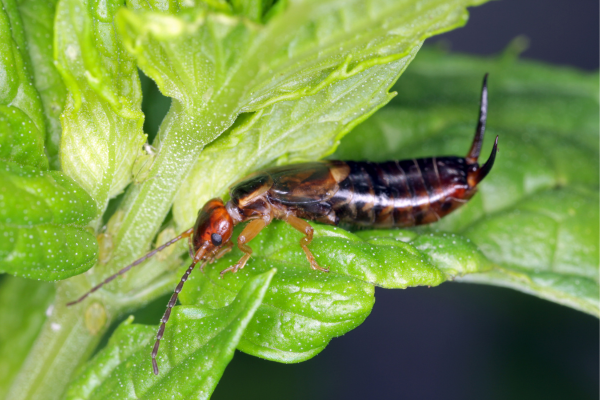Your cart is currently empty!

01 Sep Earwigs 101: Introduction To These Mysterious Insects
Have you ever encountered an odd-looking insect with menacing pincers at the rear of its abdomen? If so, you might have come across an earwig. Despite their intimidating appearance, earwigs are fascinating creatures with a rich natural history. In this blog, we will discuss earwigs 101, and explore their anatomy, behaviour, life cycle, and their role in the ecosystem.
What Are Earwigs?
Earwigs, scientifically known as order Dermaptera, are small insects characterized by their elongated bodies and prominent cerci, or pincers, located at the tip of their abdomens. There are around 2,000 known species of earwigs worldwide, with varying sizes and colours. Despite their name, earwigs do not crawl into human ears – the moniker “earwig” originates from an old belief that these insects could burrow into the human ear, which is merely a myth.
Behaviour And Habitat
Earwigs are predominantly nocturnal insects, seeking shelter during the day and becoming active at night. They are highly adaptable and can be found in a wide range of habitats, from temperate forests to arid deserts. Earwigs are commonly discovered in gardens, where they play both beneficial and detrimental roles.
One of the misconceptions about earwigs is that they are harmful to humans and plants. While some species may cause minor damage to crops and ornamental plants, many earwig species are beneficial predators, consuming other insects, including aphids and caterpillars. This makes them valuable allies in natural pest control.
Life Cycle
Like all insects, earwigs undergo metamorphosis, progressing through several stages in their life cycle. They start as eggs laid in the soil by adult females during the fall or spring. The female earwig fiercely protects her eggs until they hatch.
Upon hatching, earwig nymphs resemble miniature versions of adults but lack wings and reproductive structures. As they grow, they moult multiple times, shedding their exoskeleton to accommodate their increasing size. Eventually, they reach adulthood and develop their characteristic wings and pincers.
The Role Of Earwigs In The Ecosystem
Despite their sometimes-negative reputation, earwigs play crucial roles in the ecosystem. As nocturnal predators, they help control populations of harmful insects, limiting potential outbreaks that could devastate crops and gardens. Additionally, earwigs are part of the diet of various animals, including birds, mammals, and other insects, contributing to the intricate web of interactions within ecosystems.
Interactions With Humans
In general, earwigs prefer to avoid human contact, but they may occasionally wander into homes seeking shelter or moisture. When disturbed, they might release a foul-smelling liquid as a defence mechanism. While earwigs are harmless to humans, their presence indoors can be unsettling.
Managing Earwig Populations
For those concerned about earwigs in their gardens, there are several strategies for managing their populations without resorting to harmful pesticides. Simple techniques, such as reducing excessive moisture and providing alternative shelter for earwigs away from valuable plants, can be effective.
In conclusion, earwigs are intriguing insects that often evoke curiosity and apprehension due to their unique appearance and the myths surrounding them. As we’ve discovered, they are an essential part of the ecosystem, contributing to pest control and serving as a valuable food source for various animals. Understanding their role and behaviour can help us coexist with these mysterious insects and appreciate their contributions to the natural world.
Next time you encounter an earwig in your garden, take a moment to observe its fascinating features and appreciate the vital role it plays in maintaining the delicate balance of nature. Earwigs may be enigmatic creatures, but with knowledge and understanding, we can demystify their presence and live harmoniously alongside them.
Now that we’ve learned about the fascinating world of earwigs and their essential role in the ecosystem, it’s time to take action to safeguard your garden from potential pests like fleas and chinch bugs. One of the best ways to achieve natural pest control without harmful chemicals is by using Nema Globe Flea & Chinch Bug Buster.
Visit the Environmental Factor website and take the first step towards a healthier, thriving garden. Remember, by choosing Nema Globe Flea & Chinch Bug Buster, you’re not only protecting your plants, but you’re also contributing to a sustainable and eco-friendly approach to pest control.


